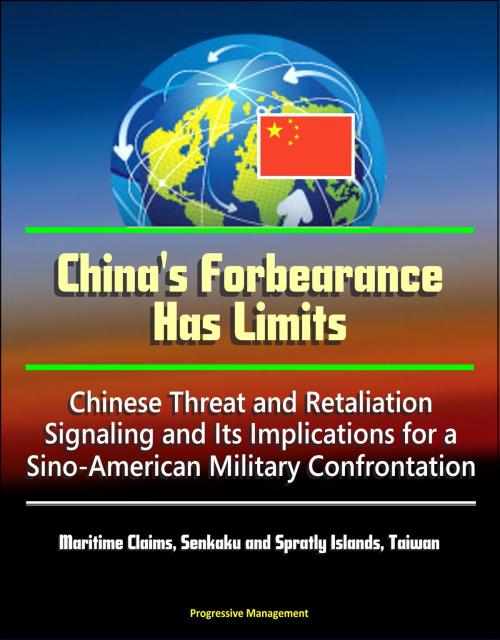China's Forbearance Has Limits: Chinese Threat and Retaliation Signaling and Its Implications for a Sino-American Military Confrontation - Maritime Claims, Senkaku and Spratly Islands, Taiwan
Nonfiction, History, Asian, China, Military, United States| Author: | Progressive Management | ISBN: | 9781311377623 |
| Publisher: | Progressive Management | Publication: | February 24, 2014 |
| Imprint: | Smashwords Edition | Language: | English |
| Author: | Progressive Management |
| ISBN: | 9781311377623 |
| Publisher: | Progressive Management |
| Publication: | February 24, 2014 |
| Imprint: | Smashwords Edition |
| Language: | English |
This report from the Center for the Study of Chinese Military Affairs of the Institute for National Strategic Studies provides a thorough discussion of the use of the Chinese military in past and future confrontations, including historic information about previous signals of military intention and possible future military threats regarding disputed islands. Contents: The Record: Beijing's Use of Military Force * China's Crisis Decisionmaking Process and Crisis Management * Signaling the Intent to Employ Military Force— China's Warnings Calculus * Signaling Case Studies—Taiwan * Analyzing Beijing's Signals—Things to Consider * Conclusion—A Hypothetical South China Sea Signaling Scenario * Appendix 1. Chronology of the 1978-1979 Sino-Vietnamese Border Crisis * Appendix 2. Chronology of the 1961-1962 Sino-Indian Border Crisis * Appendix 3. PRC Signaling Over Taiwan: 1991, 1995, 1999, 2003-2004
Since its founding in 1949, the People's Republic of China (PRC) has employed military force in defense of China's security and territorial integrity. In many such instances, Beijing implemented a calculus of threat and retaliation signals intended first to deter an adversary from taking actions contrary to Chinese interests by threatening the use of military force and, if deterrence failed, to explain and justify Beijing's resort to military force.
This deterrence calculus was applied in each of the major instances in which Beijing has resorted to military force—in Korea in 1950, in the Sino-Indian border dispute in 1961-1962, in the Sino-Soviet border dispute in 1968-1969, and in China's attack on northern Vietnam in 1979. It was also applied in instances in which Beijing's effort at deterrence apparently succeeded and China ultimately stopped short of using military force. Examples include China's responses to the intensifying American combat effort in Vietnam in 1965-1968 and to the 1991 debates in Taipei about delimiting the Republic of China's sovereignty claims.
Beijing implements this deterrence calculus by a carefully calibrated hierarchy of official protests, authoritative press comment, and leadership statements. If the crisis persists and Beijing perceives its interests are not satisfactorily taken into account, its statements escalate in level and may include at first implicit and thereafter increasingly explicit warnings that it may use military force to achieve its goals. This approach has been employed consistently despite the sweeping changes in the PRC's place in the international order, the proliferation of foreign policy instruments at its disposal, the more complex crisis decisionmaking process and domestic political environment, and the dramatic evolution in the Chinese media over the decades. The question for U.S. policymakers is whether improving military capabilities will lead Beijing to substitute sudden or surprise attack for the politically calibrated deterrence signaling it has employed prior to its past use of force. This study assesses the problem in four ways.
In addition to the China paper, this unique collection of American military documents provides a special view of recent Chinese military and policy developments. Contents: China Shaping the Operational Environment - A Disciple on the Path of Deception and Influence * The "People" in the PLA: Recruitment, Training, and Education in China's 80-Year-Old Military * China's Maritime Quest * The PLA At Home and Abroad: Assessing The Operational Capabilities of China's Military * Arms Sales To Taiwan: Enjoy The Business While It Lasts * China's Role In The Stabilization Of Afghanistan * The Coming of Chinese Hawks * Turkey and China: Unlikely Strategic Partners. This ebook also includes the annual U.S. intelligence community worldwide threat assessment in Congressional testimony by Director of National Intelligence James R. Clapper Jr.
This report from the Center for the Study of Chinese Military Affairs of the Institute for National Strategic Studies provides a thorough discussion of the use of the Chinese military in past and future confrontations, including historic information about previous signals of military intention and possible future military threats regarding disputed islands. Contents: The Record: Beijing's Use of Military Force * China's Crisis Decisionmaking Process and Crisis Management * Signaling the Intent to Employ Military Force— China's Warnings Calculus * Signaling Case Studies—Taiwan * Analyzing Beijing's Signals—Things to Consider * Conclusion—A Hypothetical South China Sea Signaling Scenario * Appendix 1. Chronology of the 1978-1979 Sino-Vietnamese Border Crisis * Appendix 2. Chronology of the 1961-1962 Sino-Indian Border Crisis * Appendix 3. PRC Signaling Over Taiwan: 1991, 1995, 1999, 2003-2004
Since its founding in 1949, the People's Republic of China (PRC) has employed military force in defense of China's security and territorial integrity. In many such instances, Beijing implemented a calculus of threat and retaliation signals intended first to deter an adversary from taking actions contrary to Chinese interests by threatening the use of military force and, if deterrence failed, to explain and justify Beijing's resort to military force.
This deterrence calculus was applied in each of the major instances in which Beijing has resorted to military force—in Korea in 1950, in the Sino-Indian border dispute in 1961-1962, in the Sino-Soviet border dispute in 1968-1969, and in China's attack on northern Vietnam in 1979. It was also applied in instances in which Beijing's effort at deterrence apparently succeeded and China ultimately stopped short of using military force. Examples include China's responses to the intensifying American combat effort in Vietnam in 1965-1968 and to the 1991 debates in Taipei about delimiting the Republic of China's sovereignty claims.
Beijing implements this deterrence calculus by a carefully calibrated hierarchy of official protests, authoritative press comment, and leadership statements. If the crisis persists and Beijing perceives its interests are not satisfactorily taken into account, its statements escalate in level and may include at first implicit and thereafter increasingly explicit warnings that it may use military force to achieve its goals. This approach has been employed consistently despite the sweeping changes in the PRC's place in the international order, the proliferation of foreign policy instruments at its disposal, the more complex crisis decisionmaking process and domestic political environment, and the dramatic evolution in the Chinese media over the decades. The question for U.S. policymakers is whether improving military capabilities will lead Beijing to substitute sudden or surprise attack for the politically calibrated deterrence signaling it has employed prior to its past use of force. This study assesses the problem in four ways.
In addition to the China paper, this unique collection of American military documents provides a special view of recent Chinese military and policy developments. Contents: China Shaping the Operational Environment - A Disciple on the Path of Deception and Influence * The "People" in the PLA: Recruitment, Training, and Education in China's 80-Year-Old Military * China's Maritime Quest * The PLA At Home and Abroad: Assessing The Operational Capabilities of China's Military * Arms Sales To Taiwan: Enjoy The Business While It Lasts * China's Role In The Stabilization Of Afghanistan * The Coming of Chinese Hawks * Turkey and China: Unlikely Strategic Partners. This ebook also includes the annual U.S. intelligence community worldwide threat assessment in Congressional testimony by Director of National Intelligence James R. Clapper Jr.















